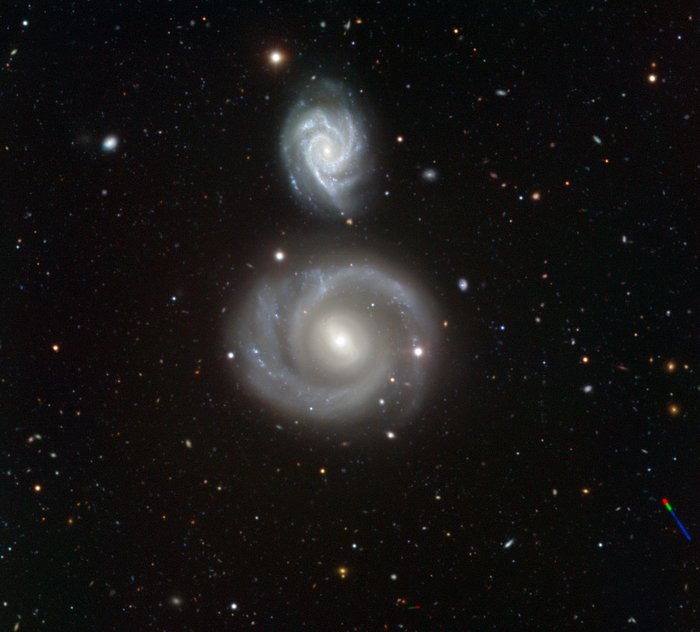Die Ruhe vor dem Sturm
Diese wunderschöne Bild portraitiert die Galaxien NGC 799 (unten) und NGC 800 (oben), die im Sternbild Walfisch liegen. Das Galaxienpaar wurde erstmalig vom amerikanischen Astronomen Lewis Swift im Jahr 1885 beobachtet.
Die Draufsicht erlaubt es uns ihre Gestalt auch in einer Entfernung von ungefähr 300 Millionen Lichtjahren klar wahrzunehmen. Wie die Milchstraße – unsere Galaxis – sind beide Himmelsobjekte Spiralgalaxien mit charakteristischen, langen Armen, die sich um die helle Wölbung ins Zentrum (den sogenannten Bulge) winden. In den hervorstechenden Spiralarmen bilden sich eine große Zahl von heißen, jungen und blauen Sternen, die sich in Haufen ansammeln (die winzigen blauen Punkte, die im Bild sichtbar sind), während im zentralen Bulge eine große Zahl von kühleren, älteren Sternen in einer dichtgepackten, fast kugelförmigen Region komprimiert sind.
Bei einem flüchtigen Blick sehen die Galaxien ziemlich ähnlich aus, aber der Teufel steckt im Detail: Außer dem offensichtlichen Größenunterschied besitzt nur NGC 799 eine Balkenstruktur, die sich vom zentralen Kern erstreckt, und die Spiralarme winden sich aus den Enden des Balkens. Die Astronomen gehen davon aus, dass galaktische Balken einen Mechanismus darstellen, der Gas von den Spiralarmen ins Zentrum kanalisiert und die Sternbildung anregt. In NGC 799 wurde im Jahr 2004 eine Supernova beobachtet, der der Name SN2004dt gegeben wurde.
Ein weiteres unterschiedliches Detail ist die Anzahl der Spiralarme. Die kleine NGC 800 hat drei helle, knotige Spiralarme, während NGC 799 nur zwei relativ schwache, aber breite Spiralarme besitzt. Diese beginnen am Ende der Spiralarme, umrunden fast komplett die Galaxie und bilden eine Struktur, die fast wie ein Ring aussieht.
Obwohl es in diesem Bild so aussieht, als ob zwei beeindruckende, nahe beieinander stehende Galaxien in ewigem Frieden koexistieren, kann nichts realistischer sein als die Wahrheit. Wir könnten gerade die Zeugen der Ruhe vor dem Sturm sein. Wir wissen nicht genau, was die Zukunft bringen wird, aber typischerweise interagieren zwei Galaxien, die so dicht beieinander stehen, über einen Zeitraum von mehreren hundert Millionen Jahren aufgrund ihrer gegenseitigen gravitativen Beeinflussung. In einigen Fällen treten nur kleine Wechselwirkungen auf, die eine Änderung des Aussehens bewirken, aber manchmal kollidieren derartige Galaxien und bilden eine einzelne, neue und größere Galaxie.
Das Bild wurde mit dem FORS1-Instrument am 8,2-Meter-Very Large Telescope (VLT) der ESO auf dem Gipfel des Cerro Paranal gewonnen. Es kombiniert Einzelaufnahmen, die durch drei Filter aufgenommen wurden (B, V, R).
Fünf Asteroiden sind sichtbar – können Sie alle auffinden? Die Asteroiden haben sich in den unterschiedlichen Belichtungen weiterbewegt und hinterlassen farbige Streifen im Bild.
Bildnachweis:ESO
Über das Bild
| ID: | potw1332a |
| Sprache: | de-be |
| Typ: | Beobachtung |
| Veröffentlichungsdatum: | 12. August 2013 10:00 |
| Größe: | 1980 x 1789 px |
Über das Objekt
| Name: | NGC 799, NGC 800 |
| Typ: | Local Universe : Galaxy : Type : Spiral |
| Entfernung: | 300 Million Lichtjahre |
| Constellation: | Cetus |
Bildschirm-Hintergrundbilder
Koordinaten
| Position (RA): | 2 2 12.31 |
| Position (Dec): | 0° 6' 3.41" |
| Field of view: | 6.60 x 5.96 arcminutes |
| Orientierung: | Die Nordrichtung liegt 180.0° rechts zur Vertikale |
Farben & Filter
| Spektralbereich | Teleskop |
|---|---|
| Optisch B | Very Large Telescope FORS1 |
| Optisch V | Very Large Telescope FORS1 |
| Optisch R | Very Large Telescope FORS1 |

